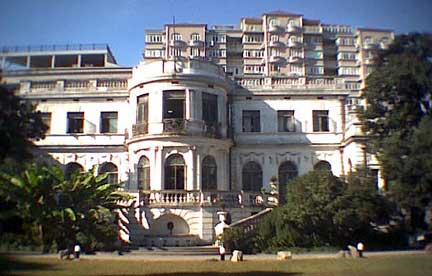|
China - Better Check This Out |
| FTLComm - Shanghai, China - Wednesday, March 6, 2002 Images by Ensign staff reporter |
 Yesterday I went to check out the maps that I could find on line for Northeastern China and I was shocked. First of all maps of almost any place on earth are not easy to come by on the Internet. This is something that has changed over the past few years as what had been free sites now all seem to be commercial things and even what is available commercially turns out to be less than adequate. I discussed the issue with a teacher who went and purchased a CD of maps and was extremely disappointed. Though was the initial finding in my search the most significant thing I discovered was my complete and total lack of awareness of this part of the world. A few days ago I was telling readers to get a globe and tour the world, now its time to take my own advice. After only a few sites of investigation I was feeling pretty lost. Quite simply as an undergraduate my minor was in human geography, therefore I had assumed that I was fairly familiar with places |
 around the world, though I have not traveled beyond North America, my reading and study of both history and geography is well ahead of many of my peers. But China! Complete and total ignorance. In the fall an associate and contributor to Ensign and Saskatchewan News was in Shanghai and took these remarkable pictures. |
 |
 The first set of pictures involve a cruise around Shanghai's harbour on the Haungpu River. This pictures taken in on November 15 first tell us that like the Eastern seaboard of North America Eastern coastal China has a serious smog problem. Though colour correction was applied to these images the amber air and limited visibility tells the story of industry and serious pollution. |
 |
 |
 These harbour pictures show the huge container cranes that deliver our Wal-Mart, Zellers and Canadian Tire goods to ships that make their way here with almost every durable good we purchase. |
 |
 The streets of Shanghai look remarkably like streets about anywhere but the architecture is a curious mix of very old and very modern. One of the best examples of this mixture is the Craft Institute on the right with the modern balconied apartment building in the background. What is really disturbing is to realise that Shanghai is just one of dozens of cities perched on the delta of the |
 |
 |
 Yangtze river. These are massive cities and when you look at the map at the top of the page realise that there is no open country from one of those cities to the next. Millions and millions of people live in this area. The curious idea that somehow American is the centre of the universe is profoundly out of whack with reality. From saucers to televisions, computers to sandals China is the primary manufacturer and every day US dollars |
 |
 flood the country as the outrageous imbalance of trade continues. Canada is only a little better because China buys a lot of raw materials from us to make the items that come back onto the retail stories. Most often we see a city sky line and we immediately recognise it as one of the world's major cities but as I looked at our intrepid reporters pictures these scenes were as if I was looking at a Star Trek movie or television show. Nothing is familiar. |
 |
 Above is the "pearl of the Orient" a remarkable landmark in Shanghai seen from the ground and from a neighbouring sky scraper. But look out across that smog covered background (above right) and you can see a forest of huge buildings. No doubt you too have read some of the classic novels set in Shanghai during the miserable disaster that we refer to as World War II. It is important to realise that while we all consider that war to have begun in 1939 and wrapped up in the summer of 1945 this was not the case in China. In the early thirties Japan launched its take over of Manchuria and by the middle of the decade was in control of much of the country. Canada had forces there who were captured in Hong Kong in thirty-six and some survived while many others died in the horrors of concentration camps through the next ten years. This beautiful city was bombed and ravaged by the Japanese and when the war ended the austere conditions of the revolution marched onward until some peace seemed to settle on the country after Mao's death. What is remarkable is that China feeds itself, grows commercially, has a mix of government and private industry. Shuns what |
 we know as democracy and makes extensive use of slave labour yet look at these pictures and see what they are accomplishing. Suzhou is a 5.8 million city about forty miles West of Shanghai. The picture on the right and below are of Soochow University. Notice that this computer lab is equipped with LCD flat panel screens, head phones and is beyond any similar lab in Saskatchewan. The teacher work stations below suggest that the folks who fitted out this facility know what is needed to get the job done. Check below for a few web sites that describe Suzhou and remember this is only one of many small cities in the area. |
 |
|
By: Timothy
W. Shire |
Suzhou's English daily newspaper web site |
|
|
Tourist web site for Suzhou |
|
|
In the lower reaches of the Yangtze and on the shores of Lake Taihu lies the 2, 500-year-old city of Suzhou,the cradle of Wu culture. http://www.chinavista.com/suzhou/home.html |